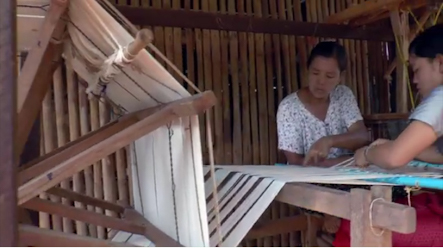
Through the ‘Made in Mon’ branding of local handicraft, women and the poor in Southeastern Myanmar are getting gainful employment opportunities.
ADB through a grant from the Japan Fund for Poverty Reduction initiated the project by upgrading handicraft production and processing facilities, providing design, manufacturing and marketing advice.
This video was originally posted on the ADB website.
Mon State, Southeastern Myanmar – It’s a place where centuries old-traditions remain a touchstone in an ever-evolving landscape and way of life.
Daw San Aye and her two daughters have made a living as fabric weavers almost their entire lives, an occupation handed down from one generation to the next.
But as this once remote region opens to new markets and trading opportunities this small family, like many in the area, remains reliant on traditional techniques to produce their stunning fabrics and provide a much-needed source of income.
The majority of handicraft production remains unorganized and part of the informal local economy - its full market potential untapped especially by the artisans and producers themselves.
Daw San Aye has long worried her daughters might need to work away from home.
“If my daughter didn’t have this job she would have to work somewhere with less income or work in the fields farming or as a laborer,” says Daw San Aye, a weaver from Thein Khone Village in the Mudon township.
“Without this work then my sister would work at a weaving center where they use chemical dyes, and I would be working in a rubber plantation,” adds Ma Nyan Htaw Mon, also a weaver from the same village.
In response, ADB through a grant from the Japan Fund for Poverty Reduction initiated the Economic Empowerment of the Poor and Women in the East-West Corridor Project which is led by the Ministry of Hotels and Tourism. The project has been supporting more than 1,000 people across Mon State.
The project and one of its key components, the ‘Made in Mon’ branding, seeks to increase gainful employment opportunities for women and the poor by upgrading handicraft production and processing facilities, providing design, manufacturing and marketing advice and facilitates access to micro-financing.
To date, the ‘Made in Mon’ branding has developed a range of new products such as hand-woven cotton textiles and garments using natural dyes, hand-made natural soaps, traditional biscuits, and dried fruits and jams.
“If our soap is for sale in big hotels or other countries we will all be very proud especially because it is “Made in Mon” and Made in our country,” explains Ma Khat Khat Wai, a soap maker from Phan Pha village, Chaungzone township.
“Yes, I will be very pleased!”
Products produced under the ‘Made in Mon’ brand helps local artisans generate and retain a larger share of profits.
The ‘Made in Mon’ brand is already finding success within the tourism sector with dedicated partners who promote and sell the brand’s high-quality handicrafts internationally.
Women and the poor are the backbone of the project. They conceive, design, implement and run the handicraft enterprises, ensuring they have a powerful stake in improving the livelihoods of community members.
“When we started we had little to show so people doubted we, as women, could do this but now we can show a lot of progress and products,” says Daw Ni Ni Aye, a cookie maker from Kwin Yeik village in the Chaungzone township.
“Many people have tasted and like our cookies. We have lots of interest from people and more want to join us.”
The unique ‘Made in Mon’ branding is a strategy that provides the high-end market with high quality, traditional and new products that can sustain livelihoods and keep families like Daw San Aye’s together.
